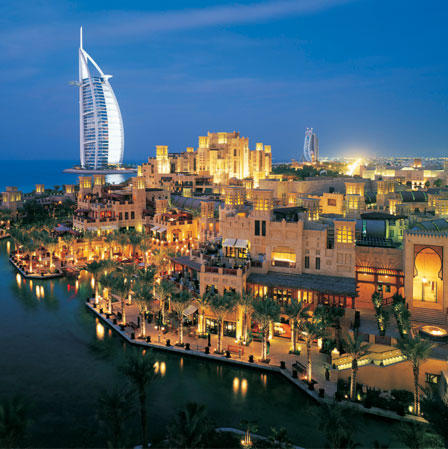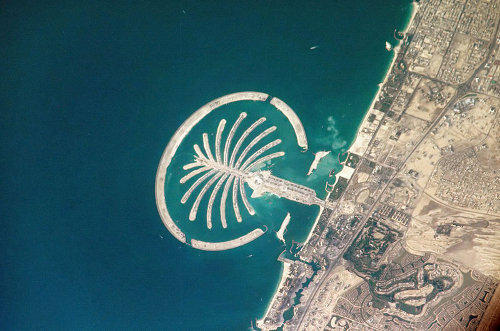Gulf States and the financial crisis
The Gulf region: an economic and financial pole
After the 9/11 attacks and the different measures of asset freeze taken by the United States, the Gulf monarchies have proceeded to a shift in their investment strategies:
- They are investing more and more in the Gulf region, the Maghreb and in Asia, as well as in Africa where they are financing some projects.
- They are no longer keen on depositing their revenues in western banks but prefer to intervene more and more in the funding, setting up and even execution of some projects like, for instance, the construction of Dakar's future airport.
- They are seeking the integration of their market into the world economy. Three emirates have franticly set themselves into this race of integration: Dubai, Bahrain and Qatar. These three new players have developed new sectors such as financial services, international trade, communication, education, air transport, real estate and tourism.
 © Jósa Piroska, CC BY-SA 3.0 © Jósa Piroska, CC BY-SA 3.0 |
In a decade, the region has emerged as a top financial place and an extremely busy business hub. Thanks to a financial surplus estimated to be over 1500 billion USD, amassed in the recent six years, Gulf States have financed real estate, tourism and industrial mega projects as well as enormous infrastructure works.
According to the figures released by the IMF the IIF (the Institute of International Finance) these new sectors of activity have provided Gulf States with revenues worth 60 to 100 billion USD in 2007.
At the start of 2008, Gulf States' investments (Saudi Arabia, Kuwait, Bahrain, United Arab Emirates, Qatar and Oman) amounted to more than 1000 billion USD.
The Gulf region financial crisis: the domino effect
Unfortunately, these new growth poles have not been spared from the current economic downturn. By developing activities that depend on the world market, Gulf State countries have been caught up by the global crisis that is shaking western economies.
Cooperation ties as well as economic and monetary dependence with the United States and Europe did not help at all.
The financial market
Caught up in the turmoil of the global meltdown, the region's stock markets and financial systems were the first to sustain the setback:
- In October 2008, the stock markets reported their first losses in six years. Between January 1, 2008 and December 31, 2008, the Riyadh Stock exchange, the first Arab financial market in terms of capitalisation, witnessed a slowdown of 56.49%. The situation did not bounce back in January 2009. In a month's time the stock markets of Gulf States lost 51 billion USD.
- Gulf States' losses are estimated at more than 400 billion USD by the end of December 2008.
- The sovereign funds, estimated at 1500 billion USD in mid 2008, have lost 450 billion USD following the American banks' disarray.
- The crisis has extended to the insurance companies which reported a slowdown of their stock market values. So far, the stock value of Tawuniya, first insurer in the Arab world, has dwindled down by 79% over 12 months. Likewise for Dubai where the insurer, Aman, has posted a 69% decline of its value in one year. Still in the same period, the Qatari company Al Khaleej Insurance has posted a 62% decline.
The petrochemical industry in the turmoil
This crisis has also affected key sectors such as petrochemistry which sustained the setback from the decrease in oil prices. Affected by the international recession and speculation, oil prices have for the first time in four years fallen below the mark of 40 dollars in December 2008. Crude oil prices have in three months dwindled from about 150 dollars a barrel down to a record low of 38 dollars.
The Gulf States, which draw more than 80% of their revenues from oil exportations , will see their oil rent fall down by almost 50% in 2009. It will amount to 257 billion USD versus 460 billion USD in 2008.
Saudi Arabia, the first oil-exporting country, has announced for the first time since 2002 a budget deficit for the year 2009.
The real estate crisis: the case of Dubai
 The housing sector, which is most vulnerable to external shocks, has been badly hit by the crisis. The economic boom, achieved by means of housing mega projects, has come to a stand-still and for an unknown period of time, with falling residential house prices as a backdrop (a slowdown of 80% is expected in 2009), scarce liquidity and stiffening lending terms by banks.
The housing sector, which is most vulnerable to external shocks, has been badly hit by the crisis. The economic boom, achieved by means of housing mega projects, has come to a stand-still and for an unknown period of time, with falling residential house prices as a backdrop (a slowdown of 80% is expected in 2009), scarce liquidity and stiffening lending terms by banks.
After “The World”, “Palm Island”, “Burj Al Arab”, “Burj Dubai”, “Hydropolis”, the ski track in the middle of the desert along with other gigantic projects, Dubai, the hardest hit among the Gulf monarchies, is running out of steam.
This “business model”, relying at 90% on the non-oil sector, has built up an economy that is fully dependant upon the liquidity surplus from Gulf States. Today, Dubai is facing a heavy debt estimated at 80 billion USD by the end of 2008, that is, 148% of its GDP.
As a result, the total sums of the frozen projects amount to 582 billion USD at the start of 2009, that is, 45% of the entire projects.
Dubai's debt is, henceforth, more costly than that of Iceland. Dubai is due to refund up to the end of 2009 15 billion USD to a consortium of international banks.
In the absence of work sites and investments, Dubai has announced on December 2008 that 45% of staff members may have to face the prospect of losing their jobs in 2009.
Financial crisis, Gulf countries' prudent policy
Despite the losses, most Gulf monarchies are rated among the countries which have resisted best to the crisis, thanks to a considerable financial surplus. The lately-cumulated reserves shall help them overcome the crisis, avoid recession, offset deficit and be able to pursue some projects.
The Saudi government has announced at the end of December 2008 that investments worth 400 billion USD over a five-year period will be maintained. Likewise for the Emirates which will pursue projects whose total costs amount to 698 billion USD.
For the time being, the year 2009 looks rocky. With the declining oil prices, the growth rate of Gulf countries will sustain a slowdown. According to the IMF, it will be of 3.5% in 2009 versus 6.8% in 2008, a temporary slowdown according to some analysts, for as of 2010 this rate is set to reach 5.4% .
Furthermore, if oil prices climb above the 45 dollar per barrel, these countries will soon be able to restore a stable growth and achieve consistent budget surpluses.
The Gulf region's role of stabilizer in period of crisis
On the international level, the financial assistance of Gulf oil States monarchies was requested at the outbreak of the crisis by a number of western states keen on rescuing the international financial system.
By committing to maintaining the different investment programs in 2009, these monarchies will contribute to cushioning the impact of the crisis and will play the role of stabilizers and may be saviours of the world economy.